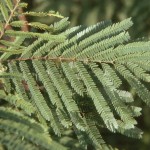Guajillo , Guajillo Acacia
Acacia berlandieri Benth.
Fabaceae (Legume family)
Description
Guajillo is a nearly thornless shrub to small tree in the Legume family. The plant height varies greatly, but it can grow up to 15 feet or 4.6 m tall. Guajillo leaves are arranged like those of mesquite, having a fern-like appearance, but are smaller. The sweet-scented, white to yellow flowers are ball-shaped are clustered in dense groups. The plant produces a flattened, bean-type legume fruit that is four to six times longer than it is wide, containing dark, brown seeds. The forage value of Guajillo is poor for livestock and wildlife except under drought conditions. However, it may be toxic when consumed as a major part of the diet.Habitat
Guajillo grows on a variety of soil types but is most prolific on ridges and shallow soils. Found mainly in the South Texas Plains and southwest Texas, it is less common in the southern Edwards Plateau and Trans-Pecos regions. It also grows extensively in northern Mexico.Toxic Agent
Guajillo poisons sheep, goats, and possibly cattle. The leaves contain excitatory amines, principally N-methyl-β-phenethylamine and tyramine. Overconsumption may cause a condition in sheep and goats known as Guajillo wobbles, which may be followed by death. The lethal dose of plant material for sheep and goats has not been determined. The toxic dosage is 15 times the animal's weight in leaves and fruit consumed over several months.Signs of Livestock Ingestion
Signs of Guajillo poisoning include: Guajillo wobbles or limber leg in sheep and goats, an uncoordinated, rubbery action, usually in the rear legs; Downed animals remain alert with normal appetite; Death. At first, leg dysfunction appears only when animals are forced to move, but after several days the animal becomes unable to rise and may die. These signs are generally not apparent unless the animal has eaten Guajillo almost exclusively for at least 9 months. Research in sheep, goats and cattle has shown that the amine compounds can cause excessive release of stress hormones. As a result, certain reproductive functions (such as normal release of reproductive hormones, estrus, ovulation and testicular development) can be suppressed. Reduced pregnancy rates have been reported in nannies.Management Strategies
Historically, Guajillo has been considered a valuable browse plant that should not be grazed to the exclusion of other range forage. Recent evidence suggests that the plant has been overrated as a forage, because much of its nitrogen is of nonprotein origin and is poorly digested. Supplemental feeding and reduced stocking rates lower the incidence of poisonings. At the first signs of illness, move the animals to a pasture with more varied browse and especially herbaceous forage. Animals placed on an adequate ration may recover. Managers should give animals alternatives to shrub foliage and avoid overstocking pastures.Images
Plant Characteristics
Flower Color: White, Yellow
Seed Type: Bean/Pod
Duration: Perennial
Stem Texture: Hairless/Smooth
Growth Habit: Shrub (Woody)
Leaf Shape
 : Bipinnately Compound
: Bipinnately Compound
Season: Warm
Distribution
 : 02 - Gulf Prairies and Marshes, 06 - South Texas Plains, 07 - Edwards Plateau, 10 - Trans-Pecos
: 02 - Gulf Prairies and Marshes, 06 - South Texas Plains, 07 - Edwards Plateau, 10 - Trans-Pecos
Distributions
Distribution refers to the ecological region in Texas that a plant has been found. You can also view a clickable map.
Book: Brush and Weeds of Texas Rangelands (B-6208), Toxic Plants of Texas (B-6105)
Collection: Brush and Weeds, Toxics
Livestock Affected: Cattle, Goats, Sheep
Livestock Signs: Incoordination, Loss Of Weight, Unable To Rise







